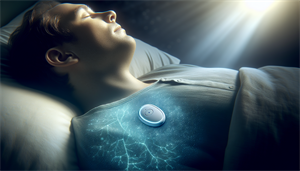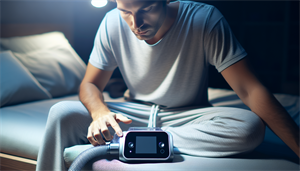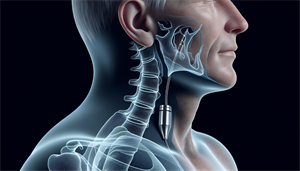What is the newest treatment for sleep apnea? Revolutionary therapies like the Inspire system are transforming patient care. In this article, we tackle the latest innovations in sleep apnea treatment including the Inspire system, as well as enhanced CPAP and BiPAP technologies. Understand their mechanisms, who can benefit, and the impact on sleep health, with straightforward insights and no excess jargon.
Key Takeaways
-
The Inspire system, a novel treatment for sleep apnea that involves hypoglossal nerve stimulation, provides an alternative to traditional CPAP therapy and requires specific qualifications and a minor surgical procedure for implantation.
-
Technological advances in positive airway pressure devices, such as more comfortable and customizable CPAP and BiPAP machines, have improved patient compliance and satisfaction by catering to individual breathing needs and enhancing wearability.
-
Comprehensive sleep apnea management includes lifestyle interventions like weight loss, increased physical activity, and dietary changes, along with ongoing research to develop new treatments and address related comorbidities for overall health improvement.
Exploring the Latest Breakthrough in Sleep Apnea Therapy

One of the most significant advancements in sleep apnea treatment is the Inspire system. This FDA-sanctioned therapy employs hypoglossal nerve stimulation to maintain an open airway during sleep, offering a viable alternative to traditional continuous positive airway pressure (CPAP) therapy. A sleep study may be conducted to determine the effectiveness of this treatment for individual patients.
Not everyone qualifies for this treatment, but for those who do, it has proven to be a game-changer in managing mild sleep apnea, severe sleep apnea, and obstructive sleep apnea.
The Inspire System: An Overview
The Inspire system, designed to keep the airway open during sleep, is a small device implanted under the skin. It comprises a breathing sensor, a nerve stimulator, and a remote that work together to adjust the position of the tongue, thereby facilitating unobstructed breathing. Unlike traditional CPAP therapy, which can be uncomfortable due to the mask and constant air pressure, the Inspire system delivers mild signals to the nerves controlling the tongue, offering a more comfortable and effective alternative.
The Inspire system moves the tongue and palate forward by synchronizing these signals with the breathing cycle, thus keeping the airway open during sleep. Aside from its effectiveness, this therapy is also well-tolerated by most patients, as the stimulation is designed to be non-disruptive and non-painful.
Qualifying for Inspire Therapy
Specific criteria determine the eligibility for Inspire therapy. The potential candidates should be at least 18 years old, diagnosed with moderate to severe obstructive sleep apnea, and have experienced challenges with traditional CPAP therapy. To further evaluate the patient’s suitability for the therapy, a sedated endoscopic exam is performed, which involves a drug-induced sleep endoscopy (DISE) to assess the upper airway for obstructions or collapse.
The actual implantation of the Inspire device is a quick, outpatient surgical procedure lasting approximately 2 to 3 hours. Following the surgery, patients can expect some discomfort and swelling at the incision sites, which are normal parts of the recovery process.
Procedure and Recovery Insights
The implantation procedure involves placing the Inspire device under the skin of the neck and chest. This device delivers mild stimulation to the nerve responsible for controlling tongue and airway muscle movements, thereby maintaining open airways during sleep. After the procedure, patients are advised to rest for a few days and refrain from engaging in strenuous activities. During this recovery period, they gradually reintroduce a regular diet.
In terms of follow-up care, regular check-ups once or twice a year are necessary to ensure the proper functioning of the device. Additionally, the battery of the Inspire device will need replacement approximately every 11 years.
Advancements in Positive Airway Pressure Devices

While the Inspire system represents a significant leap forward, it’s not the only advancement in sleep apnea treatment. Other advancements include:
-
Positive airway pressure devices, such as CPAP machines, which have seen substantial improvements
-
BiPAP machines, which provide different pressure levels for inhalation and exhalation
-
Auto-adjusting CPAP machines, which automatically adjust the pressure based on the individual’s needs
These advancements offer more options for sleep apnea patients to find the treatment that works best for them.
Designed to provide a personalized treatment experience, these machines adapt the pressure according to the user’s needs.
BiPAP and Auto-Adjusting CPAP
BiPAP and auto-adjusting CPAP machines offer dynamic adaptability, providing varying pressure levels based on the patient’s needs. Auto-adjusting CPAP, also known as APAP, uses continuous monitoring of the patient’s breathing patterns to dynamically adjust the air pressure, ensuring that the patient receives tailored treatment for their sleep apnea.
In contrast, BiPAP machines offer:
-
Separate pressure settings for inhalation and exhalation
-
A more comfortable and natural breathing experience
-
Better suitability for specific types of sleep apnea
-
Customizable pressure levels
These features make bilevel positive airway pressure (BiPAP) machines a preferred option for many patients.
Design and Wearability Improvements
Advancements in positive airway pressure devices extend beyond functionality to include design and wearability. The recent design improvements in CPAP devices, such as quieter pumps, softer masks, and enhanced portability, have significantly improved patient comfort and convenience, making positive airway pressure therapy more accessible to those in need.
Technological advancements have given rise to micro CPAP devices that are small, lightweight, and devoid of large masks and tubes. Moreover, the integration of CPAP therapy with wearable technology, like smartwatches and fitness trackers, offers more tailored care, improving comfort for individuals with sleep apnea.
Certain CPAP masks also use innovative materials, like the SleepWeaver Advanced cloth, known for its non-allergenic and breathable properties, further enhancing user comfort.
Oral Appliances: A Tailored Approach

Beyond CPAP machines and surgical innovations, oral appliances offer another tailored approach to managing sleep apnea. These custom-made devices, crafted by qualified dentists, are designed to fit an individual’s mouth shape, providing a secure and comfortable fit.
Patients who are intolerant to PAP therapy or seeking its alternatives can particularly benefit from this form of therapy.
Effectiveness and Patient Satisfaction
Customized oral appliances have demonstrated greater efficacy than non-custom oral appliances in managing sleep apnea. The precise fit of the appliance and patient characteristics play significant roles in determining the treatment’s effectiveness. These appliances hold the lower jaw forward, facilitating better breathing during sleep. The benefits of using customized oral appliances include:
-
Reduced snoring
-
Improved blood pressure control
-
Enhanced neurocognitive function
-
Decreased depressive symptoms
-
Overall improvement in sleep quality and quality of life.
Patients have expressed high levels of satisfaction with customized oral appliances, rating their therapy satisfaction an average of 8 out of 10. This preference is attributed to the comfort and convenience of the appliances compared to CPAP devices, which contributes to improved compliance with treatment.
Surgical Innovations: Beyond Uvulopalatopharyngoplasty (UPPP)

Surgical interventions are also integral in managing sleep apnea. Beyond traditional surgical procedures like Uvulopalatopharyngoplasty (UPPP), innovative surgical methods like upper airway stimulation therapy have emerged, offering new treatment options for patients who are not ideal candidates for traditional therapies.
Mayo Clinic’s interdisciplinary approach to critical care medicine streamlines the process for patients seeking these alternative therapies, enhancing the efficiency and customization of the treatment process.
Upper Airway Stimulation Therapy
Upper airway stimulation therapy is a recent innovation in the field of sleep apnea treatment. This therapy involves:
-
The implantation of a device in the upper chest
-
The device delivers mild stimulation
-
Helps to keep the airway open
-
Reduces pauses in breathing during sleep
Studies have demonstrated its efficacy, with a significant reduction in the apnea-hypopnea index (AHI) observed at the 12-month follow-up, indicating successful reduction of obstructive events. Additionally, the body mass index of the participants was taken into consideration during the study.
The implantation of the upper airway stimulation device offers several advantages:
-
It is an outpatient procedure, indicating that the process is minimally invasive with quick recovery times.
-
The therapy shows a significant increase in hours of device usage compared to CPAP therapy, indicating improved compliance and potentially greater comfort with the implanted device.
-
The overall rates of complications for patients undergoing this therapy are low, reinforcing a strong safety profile.
Lifestyle Interventions and Sleep Apnea Management

In addition to medical treatments, lifestyle interventions are also vital in managing sleep apnea. Here are some effective strategies:
-
Weight loss
-
Regular physical activity
-
Abstaining from alcohol and tobacco
-
Avoiding certain medications
-
Improving sleep hygiene
Regular physical activity, in particular, plays an instrumental role in reducing body fat around the airways, potentially lowering the severity of sleep apnea. Moreover, exercise can help strengthen mouth and throat muscles, which may reduce obstruction during sleep and contribute to better overall sleep quality.
Changing one’s diet can also provide substantial benefits in managing sleep apnea. Programs focused on dietary management have been associated with reductions in sleep apnea severity and improvements in perceived sleep quality. Weight management, increases in aerobic physical activity, and the elimination of alcohol and smoking have been particularly beneficial in this regard.
The Role of Research in Unveiling New Treatments
The continuous development and improvement of treatment options hinge on ongoing sleep apnea research. Research plays a pivotal role in:
-
Enhancing our understanding of the underlying causes and mechanisms of the condition
-
Identifying new treatment options and approaches
-
Improving the effectiveness and efficiency of existing treatments
The potential implications of ongoing research are immense. It has the potential to pave the way for the development of new drug treatments for sleep apnea, thereby broadening the scope of available options for managing the condition.
Sleep Apnea and Comorbidities: Addressing the Bigger Picture
It’s insufficient to understand sleep apnea as a standalone condition. The condition is often linked with other health problems, known as comorbidities, such as cardiovascular diseases, high blood pressure, diabetes mellitus, obesity, stroke, and mental health issues. Sleep disordered breathing, particularly sleep apnea, is connected to heart disease by increasing the likelihood of hypertension, heart attacks, and stroke, and is a notable risk factor for heart rhythm disorders. Furthermore, untreated sleep apnea is linked to a heightened risk of dementia, potentially leading to earlier onset or accelerated progression.
Addressing sleep apnea in the context of these comorbidities is crucial for improving patient outcomes and preventing further health complications. Treating sleep apnea can help patients effectively manage comorbid conditions like:
-
cardiovascular risks
-
hypertension
-
atrial fibrillation
-
congestive heart failure
-
stroke
-
metabolic syndrome
Summary
In conclusion, it’s clear that the landscape of sleep apnea treatment is continuously evolving, with new therapies and advancements offering more effective and comfortable solutions for patients. From the innovative Inspire system and advancements in positive airway pressure devices to the tailored approach of oral appliances and surgical innovations, there are now more options than ever for treating this common sleep disorder. However, medical treatments are just one piece of the puzzle. Lifestyle interventions, such as weight loss, exercise, and dietary changes, are equally crucial in managing sleep apnea and improving overall health. Ongoing research continues to unveil new treatments and deepen our understanding of sleep apnea and its associated comorbidities, underscoring the importance of a comprehensive approach to managing this condition.
Frequently Asked Questions
What is the best treatment for sleep apnea 2024?
The gold standard treatment for sleep apnea is continuous positive airway pressure (CPAP) therapy, although alternatives like exercise, weight loss, and oral appliances can also be effective.
Is there an alternative to a CPAP machine?
Yes, EPAP therapy is a newer alternative to CPAP, using a nasal device with valves to create air pressure when exhaling, preventing the upper airway from collapsing.
Related health topics?
Some related health topics include health and wellness.
What is the Inspire system?
The Inspire system is a hypoglossal nerve stimulator that aims to keep the airway open during sleep by adjusting the position of the tongue and maintaining an open airway, providing a potential treatment option for patients with mild sleep apnea.
How does the Inspire system work?
The Inspire system works by monitoring breathing patterns and delivering signals to the nerves controlling the tongue to keep the airway open during sleep, providing an alternative to CPAP therapy for sleep apnea patients.


